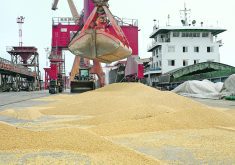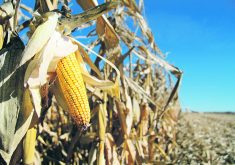NASHVILLE, Tenn. — There is a considerable risk that grain and oilseed prices could be heading for a major market correction, says a U.S. analyst.
“This market between March 31 and July 1 could take an unprecedented drop and leave (farmers) sitting there thinking, ‘how did it get so bad so quick?’” said Mark Gold, managing partner with Top Third Ag Marketing.
He believes U.S. growers are still holding a lot of the 2011 corn crop and haven’t presold much of the 2012 harvest.
“Because of how much grain the farmer has got and how much grain he can grow, this thing could get ugly in a hurry.”
Read Also

Saskatchewan, Manitoba sign Arctic Gateway deal
Saskatchewan, Manitoba and Arctic Gateway Group have signed an MOU to strengthen trade through the Port of Churchill.
Some analysts doubt U.S. farmers will be able to achieve the 164 bushel per acre average corn yield that the U.S. Department of Agriculture is forecasting for the 2012-13 crop.
Gold isn’t in that camp. He said growers can definitely reach 164 bu. per acre if Mother Nature co-operates, considering they were able to pull off a 147 bu. crop during last year’s challenging growing season.
Corn yields have declined two years in a row. A three year consecutive decline has never happened.
“That tells me the odds are against it being lower trend yield lines again,” said Gold.
There is also speculation that farmers in Ukraine will plant a lot more corn this spring, in part to make up for some of the losses to their winter wheat crops.
“The real risk in this market is in the next 90 to 100 days,” Gold told delegates attending the 2012 Commodity Classic conference.
He is one of the few people in the agriculture industry who believes corn prices could drop below $4 per bu., falling as low as $3.25 if farmers have favourable spring weather. That would drag down all crop prices.
U.S. growers are projected to plant 94 to 95 million acres of corn, up from 91.9 million acres last year. However, it could be as high as 96 million acres if planting conditions are ideal, which would result in a huge corn crop assuming an average yield of 164 bu. per acre.
“This thing will collapse in my opinion from March 31 to July 1,” said Gold.
“The market will try to force out the inefficient producers and the only way a market can do that is to get the (corn) price under the cost of production.”
Gold was slightly more optimistic about the soybean outlook because of lost production in Brazil, but he said U.S. farmers will have a more than adequate carryout.
Some analysts predict soybean acreage will lose ground to corn this spring, but Gold sees it coming out of other crops such as cotton and wheat.
He is also more bearish than others on Chinese demand and said the contraction in the U.S. livestock sector will mean decreased domestic demand for soybeans and corn.
“I look at $13 beans and $6.50 corn and $130 cattle and I believe there’s a lot of risk out there.”
Alan Brugler, president of Brugler Marketing and Management, provided a similarly depressing outlook for the wheat market.
“The problem with wheat is there’s too much of it,” he said.
Analysts forecast 57 to 58 million acres of wheat in the United States.
“My model says that’s at least 200 million bu. more production than last year at normal yields and we don’t need it,” said Brugler.
He called wheat the “wet blanket” of the grain and oilseed sector.
“Corn can get a fire started, but wheat is going to put it out,” he said.
Gold wasn’t as pessimistic about the wheat outlook because he thinks growers are going to shy away from the crop this spring.
“Guys just don’t like to grow it,” he said.
He can foresee a bullish scenario for the crop if the U.S. government uses wheat shipments to help convince “rogue nations” such as Iran and North Korea to back away from their nuclear ambitions.


















